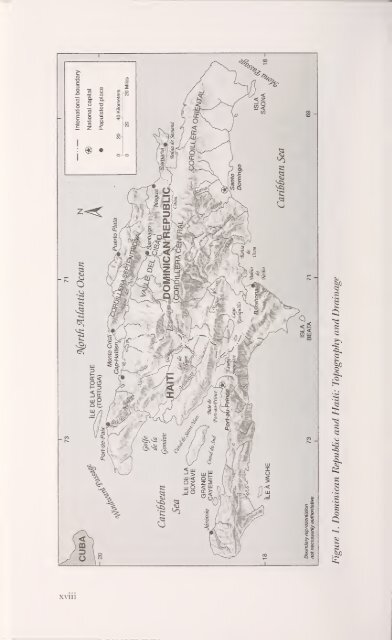Dominican Republic and Haiti: Country Studies
by Helen Chapin Metz et al by Helen Chapin Metz et al
xviii
Introduction THE HISTORIES OF THE TWO countries on the island of Hispaniola, the Dominican Republic and Haiti, have been inextricably intertwined. However, despite their similarities in some areas, they have important differences. The whole island, the first Spanish settlement in the New World and named Santo Domingo by Christopher Columbus in 1492, experienced decimation of its indigenous Indian, primarily Taino, population as a result of the Indians' treatment by colonial settlers. African slaves were brought to both sides of the island as early as the first part of the sixteenth century to supply the needed labor force for sugar plantations. Spain ruled the entire island until 1697, when, under the Treaty of Ryswick, it ceded the western third of the island, which then became known as Saint-Domingue, to France. During the eighteenth century, important demographic differences emerged. The population of Santo Domingo grew rapidly as trade reforms occurred, and by 1790 the country had some 100,000 people, roughly equal numbers of whites, free coloreds, and slaves. In contrast, Saint-Domingue, the most prosperous agricultural colony in the Western Hemisphere, had some 30,000 whites, 27,000 freedmen, and 400,000 black slaves. Differences in the economies of the two countries affected the makeup of the population. Santo Domingo engaged primarily in subsistence agriculture, requiring fewer slaves, and Spanish legislation enabled slaves to buy their freedom for relatively small sums. The result was a more egalitarian society than that of Saint-Domingue, which featured a more racially stratified population. The resultant race-based tensions in Saint-Domingue, combined with the influences of the French Revolution, led to a struggle for independence from France that started in August 1791. The rebellion began as a slave uprising against whites and developed into the Haitian Revolution, headed by such figures as Toussaint Louverture. The uprising ultimately culminated in Haiti's proclamation of independence in 1804. Meanwhile, Spain, which had suffered setbacks on the European continent and was unable to maintain its hold on Santo Domingo, turned the area over to France in a peace treaty in 1795. Toussaint entered Santo Domingo in January 1801 and xix
- Page 1: area handbook series Dominican Repu
- Page 6 and 7: On the cover: Hispaniola (La Isla E
- Page 9: Acknowledgments The authors wish to
- Page 12 and 13: Lamar C. Wilson and Patricia Kluck
- Page 14 and 15: Mass Media 199 Roman Catholic Churc
- Page 16 and 17: Higher Education 354 HEALTH 355 Fer
- Page 18 and 19: HAITI'S EXTERNAL AND DOMESTIC SECUR
- Page 21: Preface Like its predecessors, thes
- Page 25 and 26: Rafael Trujillo in the Dominican Re
- Page 27 and 28: 30,000 Haitians were reportedly dep
- Page 29 and 30: firmed by a sharply divided legisla
- Page 31: PRD," laying the groundwork for Mej
- Page 34 and 35: — Topography: Mountain ranges div
- Page 36 and 37: since 1948, Dominican Republic peso
- Page 38 and 39: — constitutional reform, Supreme
- Page 40 and 41: ^ V 9{prtft Mtantic Ocean Internati
- Page 42 and 43: Table A. (Cont.) Dominican Republic
- Page 44 and 45: Tomb of the three fathers of the Do
- Page 46 and 47: Dominican Republic and Haiti: Count
- Page 48 and 49: Dominican Republic and Haiti: Count
- Page 50 and 51: Dominican Republic and Haiti: Count
- Page 52 and 53: Dominican Republic and Haiti: Count
- Page 54 and 55: Dominican Republic and Haiti: Count
- Page 56 and 57: Dominican Republic and Haiti: Count
- Page 58 and 59: Dominican Republic and Haiti: Count
- Page 60 and 61: Dominican Republic and Haiti: Count
- Page 62 and 63: Dominican Republic and Haiti: Count
- Page 64 and 65: Dominican Republic and Haiti: Count
- Page 66 and 67: Dominican Republic and Haiti: Count
- Page 68 and 69: Dominican Republic and Haiti: Count
- Page 70 and 71: Dominican Republic and Haiti: Count
xviii



